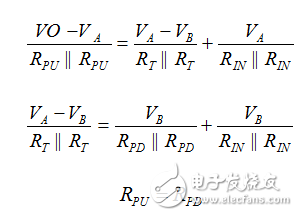RS-485 bus is widely used in communications, industrial automation and other fields. In practical applications, it is often encountered whether the need to add pull-down resistors and how large the resistors are appropriate. We will analyze these issues in detail below.

According to the RS-485 standard, when the 485 bus differential voltage is greater than +200mV, the 485 transceiver outputs a high level; when the 485 bus differential voltage is less than -200mV, the 485 transceiver outputs a low level; when the voltage on the 485 bus is at - Between 200mV and +200mV, the 485 transceiver may output a high level or a low level, but it is always in a level state. If the output of the 485 transceiver is low, this is a UART communication. At the beginning, the communication will not be normal at this time.
When the 485 bus is open (the 485 transceiver is disconnected from the bus) or idle (the 485 transceiver is all in the receiving state and the bus is not driven by the transceiver), the differential voltage of the 485 bus is basically 0, and the bus is in a state. Uncertain state. At the same time, because the current 485 chip is designed to increase the number of nodes on the bus, the input impedance is designed to be relatively high, for example, the input impedance is 1/4 unit impedance or 1/8 unit impedance (unit impedance is 12kΩ, 1/4 unit impedance is 48kΩ). It is susceptible to electromagnetic interference when the pins are suspended.
Therefore, in order to prevent the above situation of the 485 bus, usually pull up and pull down resistors on the 485 bus (usually A pull-up resistor, B bus pull-down resistor). If an isolated RS-485 transceiver module (such as RSM485PCHT) is used, since the module has an upper pull-down resistor (for the RSM485PCHT, the internal pull-up resistor is 24kΩ), there is generally no need to increase the pull-up resistor outside the module.
1. Under what circumstances do you need to add a pull-down resistor?When a signal reflection problem is encountered, signal reflection is usually avoided by adding a matching resistor, taking 1-to-1 communication as an example, as shown in Figure 1. Since the 485 bus usually uses a twisted pair with a characteristic impedance of 120 Ω, a 120 Ω termination resistor is added to the first and last ends of the 485 bus to avoid signal reflection problems.

Figure 1 Two RSM485PCHT module communication circuits
According to the specific parameters of RSM485PCHT (such as Table 1), the equivalent circuit shown in Figure 2 can be obtained. RPU and RPD are the pull-up resistors added to the 485 bus inside the module, and RIN is the input impedance of the module.
Table 1 RSM485PCHT parameters

Figure 2 RSM485PCHT communication equivalent diagram
When both modules are in the receiving state, the following formulas can be listed for Node A and Node B according to Kirchhoff's current law.

According to the above formula, the differential voltage between AB can be calculated as

At this point, the module is in an indeterminate state. The module receiver may output a high level or a low level. In this case, it is necessary to add a pull-up resistor outside the module to ensure that the module is not in an indeterminate state when it is idle.
Hydraulic Valve Lever Handle,Stackable Hydraulic Valve,Hydraulic Power Pack,Double Acting Hydraulic Pump Station
CHANGZHOU ROHN HYDRAULIC SCI-TECH CO.,LTD , https://www.rohnhydraulic.com
